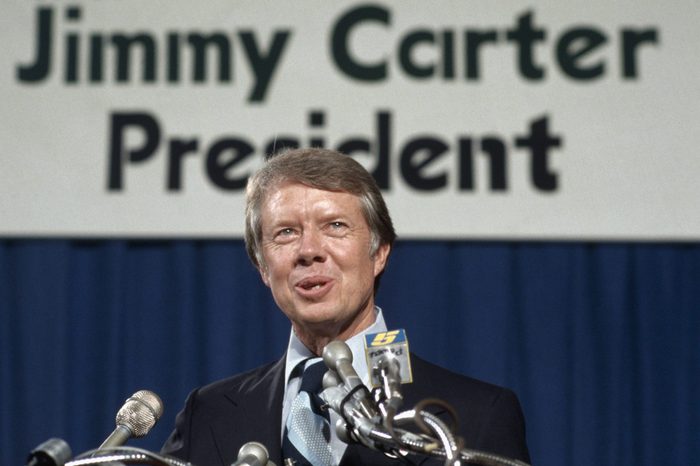
Jimmy Carter: Young man to world leader
Jimmy Carter’s young life started in a maternity ward, which might sound like a pretty ho-hum fact about a U.S. president, but in 1924, it was history-making. How’s this for a mind-boggling Jimmy Carter fact: He was the first U.S. president born in a hospital. And his birth almost didn’t happen there, but his mother, Lillian, was an on-duty nurse when she went into labor, says Laurence Cook, a presidential historian and personal friend of former President Carter and his late wife, Rosalynn.
However significant his birth was for the history books, it didn’t shape him into the humanitarian and man of the people he’d one day become. His childhood did. President Carter grew up on his family’s Georgia peanut farm, without indoor plumbing or electricity. Indeed, one of the most “important days of his life” was when “they turned the electricity on,” says Amber Roessner, professor of journalism and media history at the University of Tennessee-Knoxville and author of Jimmy Carter and the Birth of the Marathon Media Campaign. Though his father was a white supremacist, most of young Jimmy’s playmates were Black sharecroppers’ children, and his most significant role model was his Black neighbor, Rachel Clark—a second mother to Carter as a young boy.
His intelligence and innate drive distinguished him from a young age, Cook tells Reader’s Digest. His presidential achievements include driving the Middle East Peace Accords forward and brokering the Panama Canal Treaties, but his greatest contributions arguably came after his term ended in 1981. Over the past 39 years, former President Carter’s Habitat for Humanity builds have impacted thousands of lives across the globe.
When a president dies or hits a very old age, the world pauses to recall his legacy. And on Feb. 18, 2023, when the 99-year-old former president elected to live his final days in hospice care, the world began to do just that. Those touched by his kindness are remembering his strength and generosity. Those alive when he was in the White House are sharing Jimmy Carter quotes with younger generations. And we’re taking a moment to look back at photos of Jimmy Carter, young and old, to honor his life and achievements.
Get Reader’s Digest’s Read Up newsletter for more presidential facts, humor, cleaning, travel and tech all week long.
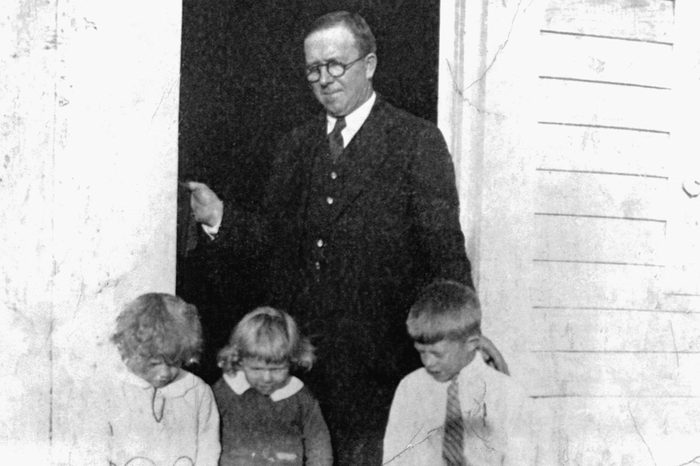
Jimmy Carter as a young boy
James Earl Carter Jr. was born on Oct. 1, 1924, to James Earl and Lillian Carter. (For the curious, here are the middle names of every other U.S. president.) This photo, taken in the early 1930s, shows future president Jimmy Carter as a young boy. Beside him: younger sisters Gloria and Ruth, along with their father.
His youngest sibling, William, isn’t in the picture, but it’s not because he didn’t figure prominently in Carter’s childhood, campaign, presidency and post-presidency life. He simply wasn’t alive—William wouldn’t be born until 1937, Roessner points out.
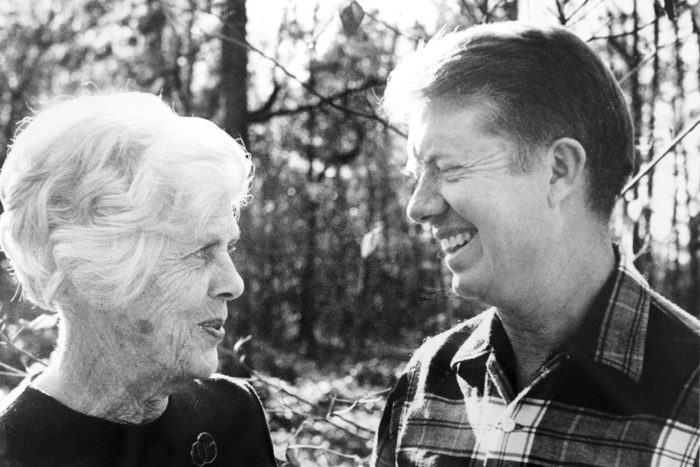
Jimmy Carter and his mother, Lillian
“Jimmy Carter had a very special relationship with his mother, who campaign reporters referred to lovingly as ‘Miss Lillian,'” Roessner tells Reader’s Digest. This photo was taken in 1976, probably not long after Lillian’s 78th birthday and shortly before the young president-elect turned 52. Throughout the summer leading up to the 1976 election, Roessner adds, the press focused a lot of attention on Miss Lillian and the rest of the Carter family.
They weren’t wrong in doing so; family has always been central to the former president’s world, according to Cook. Moreover, Lillian’s life, including her devoted service to her patients, regardless of color, “inspired Carter’s commitment to public service and to integration,” says Roessner. Like these tidbits? Find even more presidential trivia here.
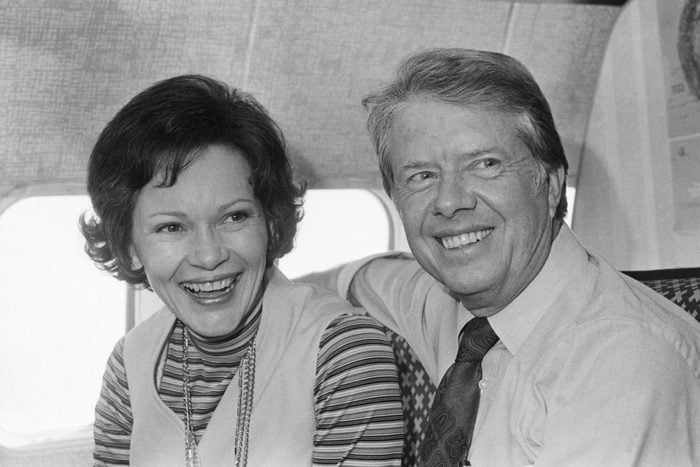
Jimmy and Rosalynn Carter
Ready for some first ladies trivia? Eleanor Rosalynn Smith was born on Aug. 18, 1927, with Lillian Carter present as a delivery nurse. You could say their lifelong partnership began in infancy. Indeed, President Carter always regarded Rosalynn as a partner, including in the White House, where, in unprecedented fashion, she attended cabinet meetings.
“I think they’re the greatest partnership in presidential history,” says Cook, who has spent extensive time with the couple over the past 20 years. They’ve been as happy in their life together as they appear in this candid photo of Rosalynn and Jimmy Carter young, taken aboard Peanut One, the Carters’s campaign plane.
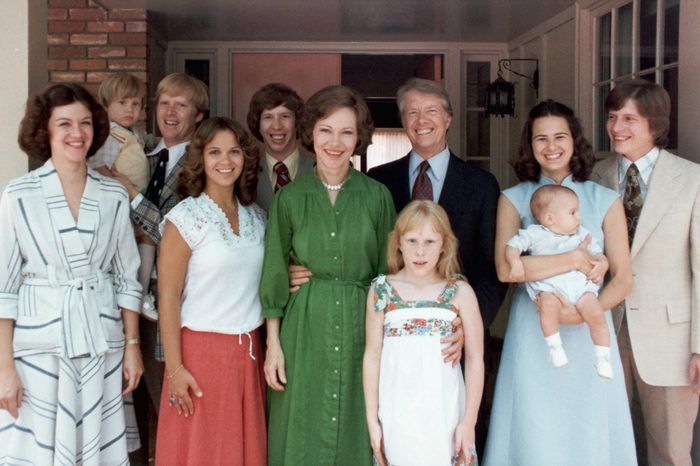
The Carter family
After marrying on July 7, 1946, Jimmy and Rosalynn Carter went on to have four children and 22 grandchildren and great-grandchildren. This portrait of their extended family was taken early in his presidency, so it includes only some of their relatives. At the far left of the photo, you’ll spot their oldest son, John William (“Jack”) Carter. Next to Jack stands their youngest son, Donnel Jeffrey (“Jeff”) Carter. And all the way to the right stands James Earl (“Chip”) Carter III, their second son.
Between the first lady and the president is their daughter, Amy Lynn, who was still a child during her father’s time in office and grew up in the White House. It’s likely that she, like members of other first families, had to follow some pretty specific first-family rules.
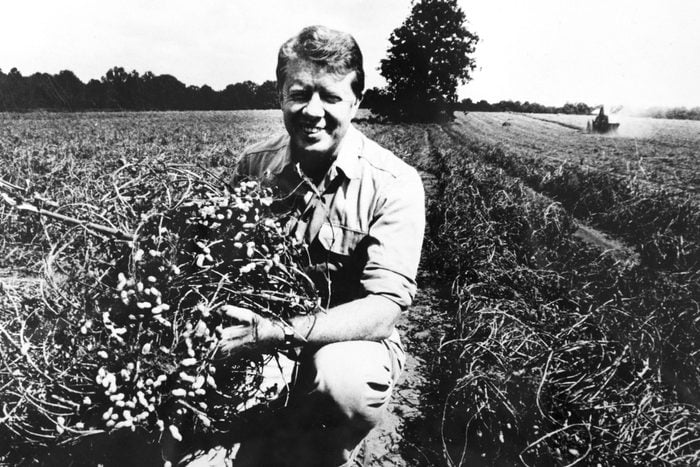
The “peanut farmer” president
Sure, he could converse with heads of state and broker treaties, but at the end of the day, the 39th president was a man of the people. Jimmy Carter, young and far from his political days, grew up on the family peanut farm in Archery, a tiny hamlet outside of Plains, Georgia. Far from a presidential secret quirk, his farming background became a key point in his campaign. In fact, President Carter, who’s scooping up freshly harvested peanut plantings in this 1976 snapshot, was positioned by his advisors as the “peanut farmer” presidential candidate, according to Roessner.
“It’s his roots, no pun intended,” Cook quips when noting President Carter’s pride at being a farmer. It formed the basis for the Peanut Brigade, one of the most “genius presidential grassroots campaigns in all of presidential history,” he says. Moreover, it helped inspire President Carter’s lifelong commitment to championing the environment and conservation.
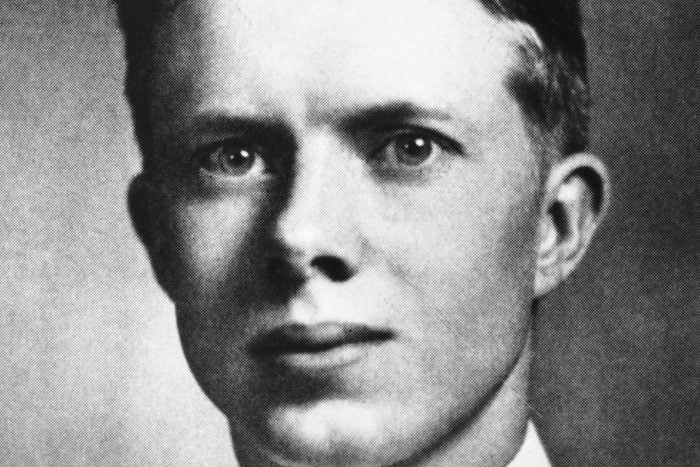
Jimmy Carter’s naval service
Inspired by his uncle Tom Gordy, a member of the Navy, Carter had aspired from age 5 to become a naval officer, and that’s exactly what he did. After graduating from Plains High School in 1941, Jimmy Carter, young and eager, did two years of undergraduate work in Georgia before his appointment to the U.S. Naval Academy. The only U.S. president to have graduated from Annapolis, he was a member of the class of 1947 but graduated a year early (unsurprisingly, he’s one of the presidents with the highest IQs).
He eventually rose to the rank of naval Lieutenant and served until his honorable discharge in 1953, when he returned home to Plains to care for his ailing father. In history books, pictures of Jimmy Carter usually center on acts of presidential grandeur, but this one—a yearbook photo—highlights the boy who became one of the most influential men in the world.
![Richard L. Thornburgh;Harold Denton;James E. Jr. Carter [& Wife]](https://www.rd.com/wp-content/uploads/2023/03/GettyImages-50369135-scaled-e1679432137768.jpg?fit=700%2C467)
A visit to Three Mile Island
On March 28, 1979, a cooling malfunction at Three Mile Island near Middletown, Pennsylvania, caused the partial meltdown of a nuclear reactor. Although the public health effects were minimal compared with the Chernobyl disaster that would happen seven years later, it was, nevertheless, the most serious nuclear accident in U.S. history. But damaged nuclear reactors were well within President Carter’s wheelhouse.
While in the Navy, he had been an officer aboard one of the earliest nuclear-powered submarines, according to Kai Bird, author of The Outlier: The Unfinished Presidency of Jimmy Carter. One of his responsibilities during that post was the cleanup of a Canadian nuclear power plant that’d had a partial meltdown. The president’s visit to Three Mile Island in the days following the accident (shown above), served as a “calming” influence for the American public, according to Cook.
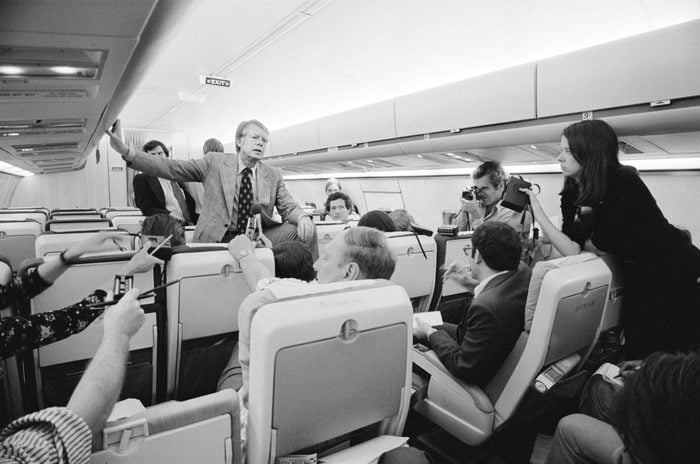
A press conference aboard Peanut One
On Sept. 11, 1976, Democratic presidential candidate Jimmy Carter held a press conference on the plane he dubbed Peanut One, a nod to his roots—and great campaign branding for him, according to Cook.
His “man of integrity” pitch, as Bird describes it, was appealing to many in the wake of Vietnam and Watergate, but it wasn’t universally adored. Sure, some gave him a hard time—when presidential hopeful Carter assured the American public “I’ll never lie to you,” his lawyer, Charlie Kirbo, quipped, “Well, there goes the liar vote.” But others, including some New York- and Washington-based political reporters, “chafed at [Carter’s] pious nature,” says Roessner, who notes that this would have “deep implications on the perceived successes and failures of the Carter White House.”
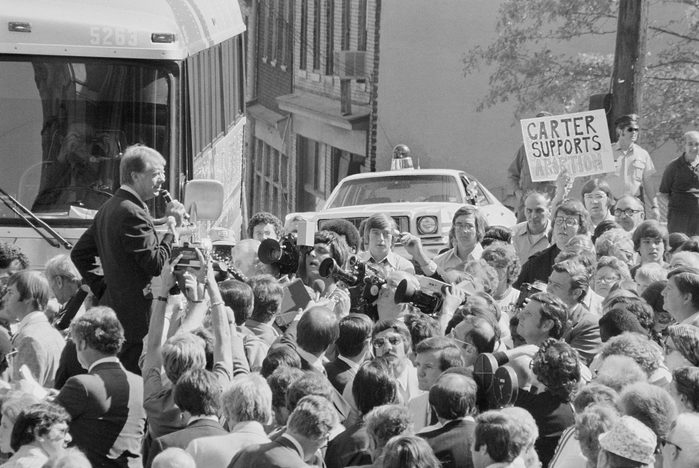
A controversial campaign stop
In the wake of the Supreme Court’s decision to overturn Roe v. Wade in 2022, abortion rights feel like a modern issue, but it’s something the American public has been debating for decades—as evidenced by this photo of a Pittsburgh campaign stop from September 1976. The “Carter Supports Abortion” sign suggests not everyone was content with the presidential candidate’s platform. But by this time, it was already well established that the “anti-establishment candidate was equally favored by liberals, conservatives and moderates,” says Roessner.
His popularity was, in part, thanks to the efforts of the “Peanut Brigade.” Initially, the group of loyal volunteers came from President Carter’s Plains, Georgia, community (some of whom Cook believes were close friends and/or family members of the Carters). But it ultimately expanded, fanning out across the nation to urge the electorate to vote Carter into office.
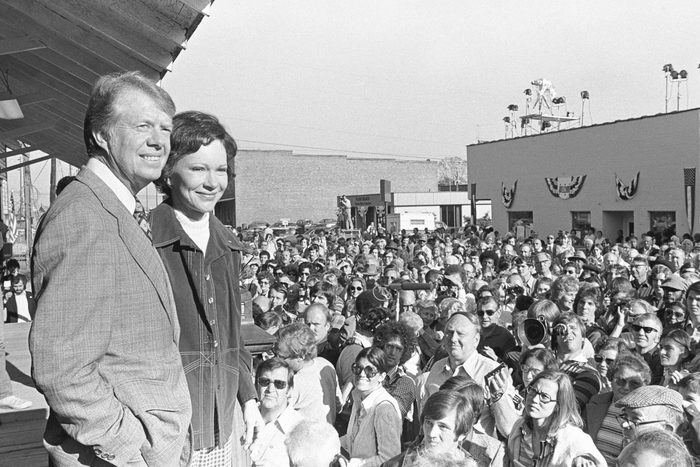
A victory lap for the president-elect
In this shot from Nov. 3, 1976, a 52-year-old Jimmy Carter and his wife greet the public after his presidential victory. His one-term presidency “changed the country and the world for the better in ways that few people even know about,” says journalist Jonathan Alter, author of His Very Best: Jimmy Carter, a Life.
Among some of President Carter’s lesser-known contributions: He got mandatory seatbelts and airbags placed in new cars, saving 9,000 American lives every year, according to Bird. He deregulated natural gas, leading to energy independence and cheaper natural gas. He deregulated the trucking and home-brewery industries, and if it weren’t for his deregulation of the airline industry, many Americans would still be hoping to someday afford to fly.
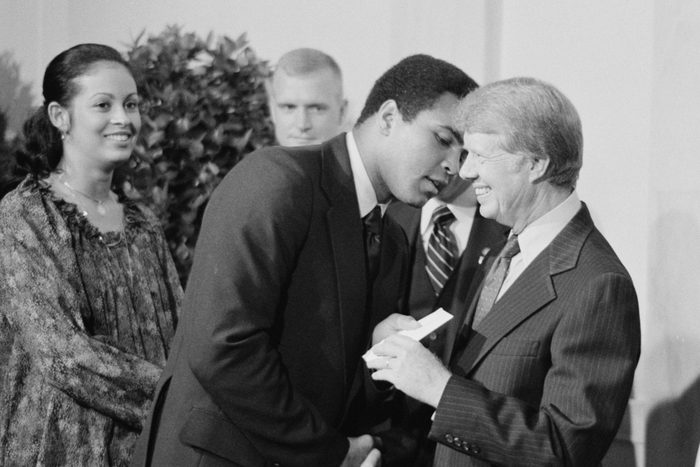
President Carter thanks Muhammad Ali
When the United States obtained the right to build and operate the Panama Canal at the turn of the 20th century, it was a major victory for America as a superpower. By the 1960s, however, the arrangement was growing volatile, so one of President Carter’s campaign promises was to hash out a new agreement with Panama. During his first year in office, he spent considerable time and energy doing so. And that involved recruiting public figures, such as boxer Muhammad Ali and actor John Wayne, to gin up support.
The signing of the Panama Canal Treaties in 1977, which ceded canal control to Panama as of Dec. 31, 1999, is considered one of the former president’s greatest accomplishments. President Carter showed his gratitude to Ali by inviting him to a celebratory White House dinner. In this photo from 1977, the two are greeting one another warmly.
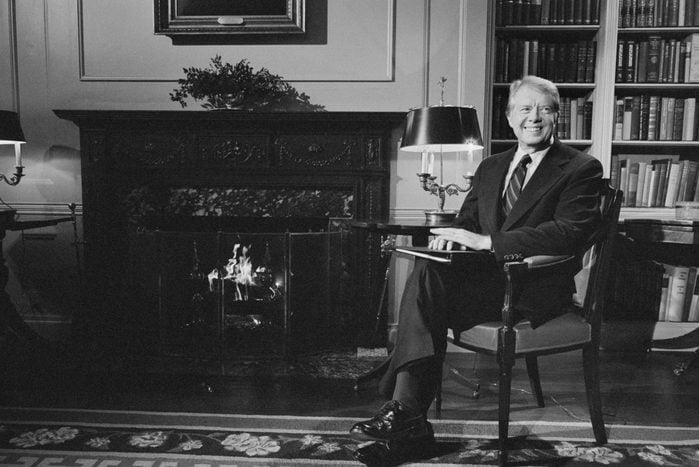
A fireside chat
The term “fireside chat” is most closely associated with President Franklin D. Roosevelt, who pioneered this informal means of communication with the American people. (At the FDR presidential library, you can listen to these.) But President Carter made brilliant use of the fireside chat as well, according to Cook.
“He wanted to talk directly to the American people, to put them at ease,” he says. “If he was talking about conservation, he’d be wearing a cardigan. He wanted to show the American people he’d do everything he was asking them to do.”
On Feb. 2, 1978, a photographer snapped this photo of President Carter before a fireside chat during which he beseeched the nation to support the senate’s ratification of the Panama Canal Treaties.
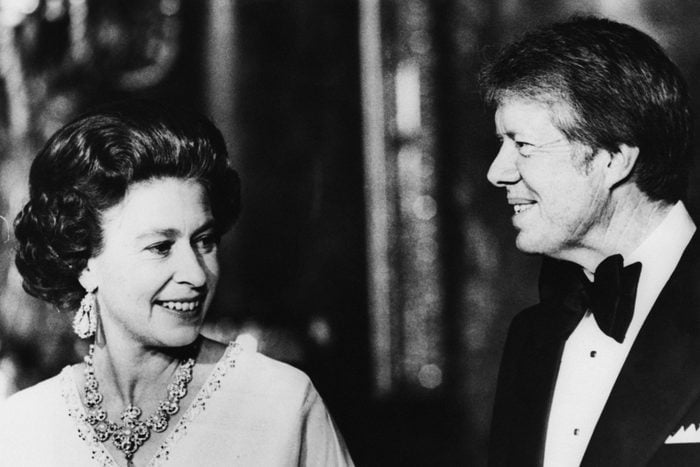
President Carter meets Queen Elizabeth II
The first time President Carter traveled overseas as president, it was to attend a G7 summit, where he addressed a NATO ministers meeting and met with various heads of state. One was Queen Elizabeth II, pictured here with Carter at a Buckingham Palace dinner on May 10, 1977.
It was probably the first time President Carter ever visited a royal palace, according to Cook, who notes that the former president was one of 13 American presidents with whom the queen met during her reign (the only president the queen didn’t meet was Lyndon B. Johnson). “Carter had a great deal of respect for the queen,” he says.
The crowd-pleasing story at the time was that President Carter supposedly kissed the Queen Mother on the lips upon meeting her. According to the former president, however, it was nothing more than a “peck on the cheek.”
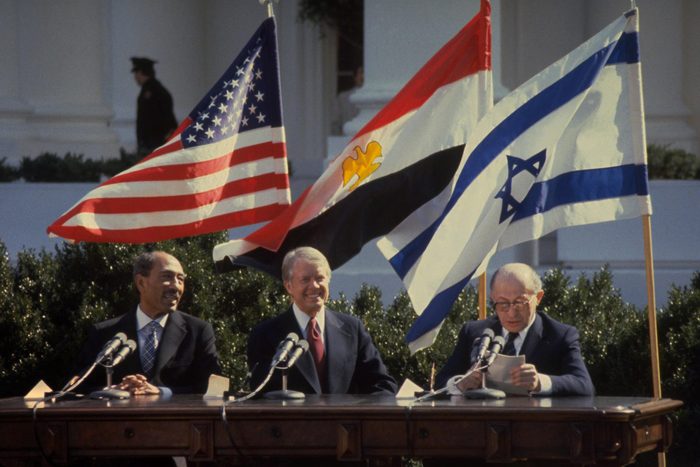
Brokering the Camp David Accords
On March 26, 1979, President Carter joined Israeli Prime Minister Menachem Begin and Egyptian President Anwar Sadat on the White House lawn to announce their signing of the historic peace treaty by which, among other things, Egypt became the first Arab nation to recognize Israel.
The treaty was the result of the Camp David Peace Accords, a long and arduous negotiation between Israel and Egypt that President Carter brokered. Establishing peace between Israel and Egypt was one of the top items on President Carter’s agenda as he took office, according to Cook. “It was a huge success, and it’s still in effect today,” he says. “Its language has always been upheld, and it has never been violated.”
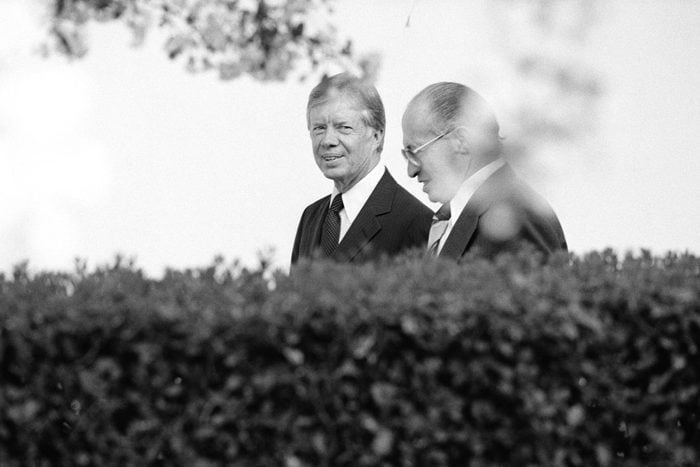
President Carter and Menachem Begin
Despite the success of the Camp David Peace Accords, the relationship between President Carter and Israeli President Menachem Begin was always somewhat fraught, according to Bird. As stubborn as President Carter had been about getting Sadat and Begin to the negotiating table (and keeping them there), Begin was equally stubborn. At various times, both Sadat and Begin threatened to pack up and leave. To get Begin to stay, Cook says, the president learned all he could about Begin’s grandchildren and then wrote personalized messages to them on autographed photos of himself, which he signed, “Love, Jimmy Carter.”
In April 1980, about a year after announcing the peace treaty, President Carter met with Begin again. Here, they’re pictured talking outside the White House.
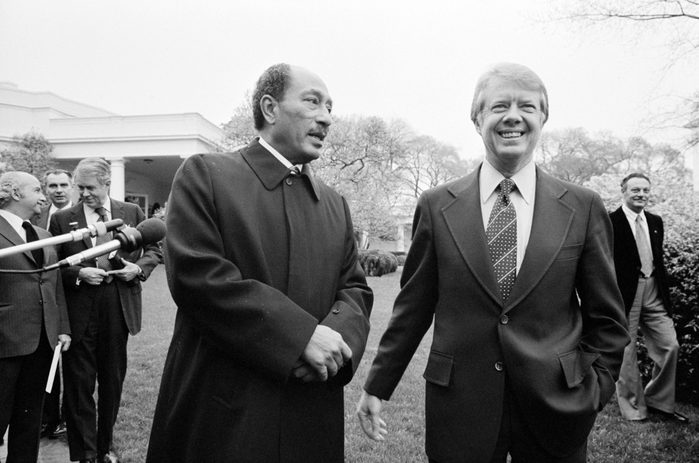
President Carter and Anwar Sadat
Begin wasn’t the only one who had to be cajoled, at times, into sticking with the negotiations at Camp David. When Egyptian President Anwar Sadat threatened to leave the peace talks, President Carter got him to stay by imploring something to the effect of, “My presidency is on the line here, and you cannot betray me by leaving,” Bird tells Reader’s Digest.
This picture of Jimmy Carter with Sadat was taken in 1977, either before the meetings at Camp David had begun or before they had gotten significantly underway. Over the 14 months of those meetings, the men developed a genuine friendship, according to Cook. Sadat’s assassination in 1981 was apparently devastating to President Carter, what Cook calls “one of the worst days of his life.”
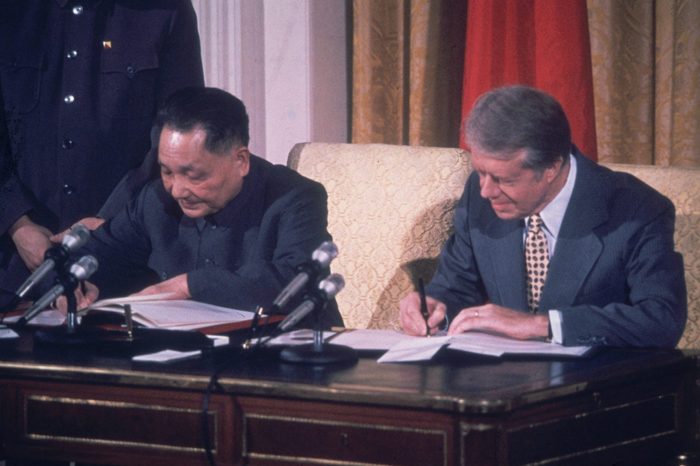
Establishing diplomatic relations with China
Another of President Carter’s great achievements during his presidency was formalizing diplomatic relations between the United States and China, according to Bird. Although both Nixon and Ford had made overtures by visiting China during their presidencies, Cook says, it was President Carter who made it official.
On Dec. 15, 1978, after months of “secret negotiations,” the United States and the People’s Republic of China announced that they had come to an understanding. When President Carter met with Deng Xiaoping, deputy premier of China, to sign accords on Jan. 29, 1979, they established formal diplomatic ties between the two nations for the first time in 30 years. Ready for some more surprising presidential firsts? We’ve got you covered.
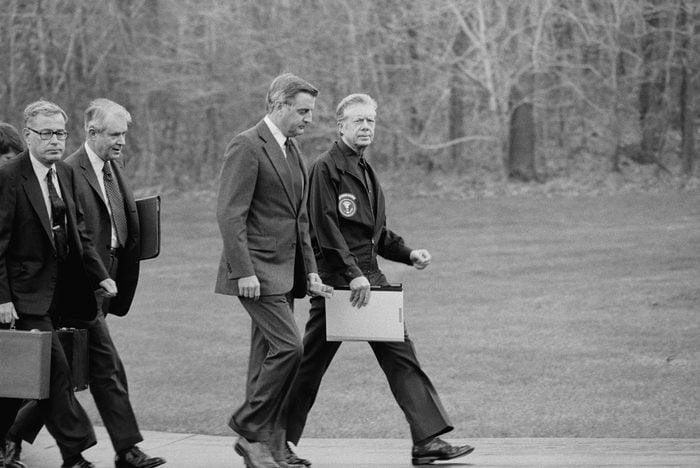
The early days of the Iranian hostage crisis
On Nov. 4, 1979, Iranian militants seized the American embassy in Iran, taking more than 60 American citizens as hostages. This photo, taken on Nov. 23, captured President Carter walking with Vice President Walter Mondale, with whom the president had a “very good relationship,” according to Cook. Secretary of Defense Harold Brown (in glasses) and Secretary of State Cyrus Vance follow a few steps behind.
The group had just arrived at Camp David to discuss the Iranian hostage crisis. As Bird notes, President Carter shouldered much of the blame for the crisis because it was on his watch that the deposed shah of Iran was allowed to visit the United States for medical treatment; the seizing of the embassy took place four days later.
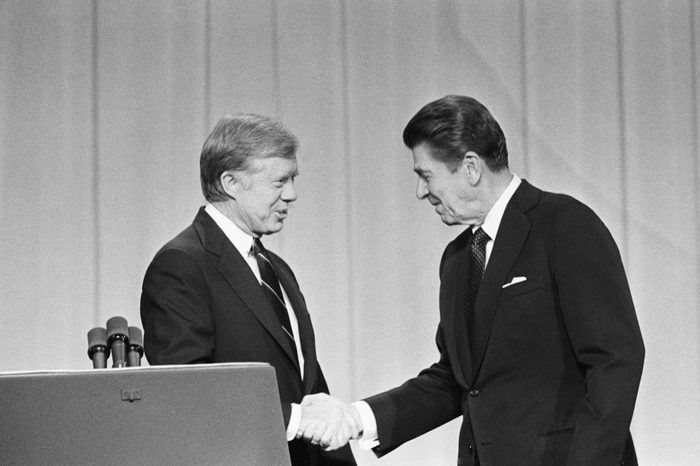
The end of President Carter’s term
During the Iranian hostage crisis, President Carter faced enormous pressure to take military action, Bird tells Reader’s Digest. Although he was adamant in his belief that doing so would endanger the lives of the hostages, upholding his convictions came at a great political cost.
When the last of the hostages were finally released on Jan. 20, 1981, it was time for a new president to take over the running of the country. President Carter had already lost the 1980 presidential election to Ronald Reagan—seen here shaking hands with Carter before a debate—in part because it had become so easy for his political enemies to paint him as “naive, weak and indecisive,” says Robert Strong, author of Working in the World: Jimmy Carter and the Making of American Foreign Policy.
Strong argues that the portrayal is inaccurate. President Carter “was more interested in getting the job done than in working the public relations,” he says. “That may not be a good formula for winning reelection, but it is not a bad way to conduct the presidency.”
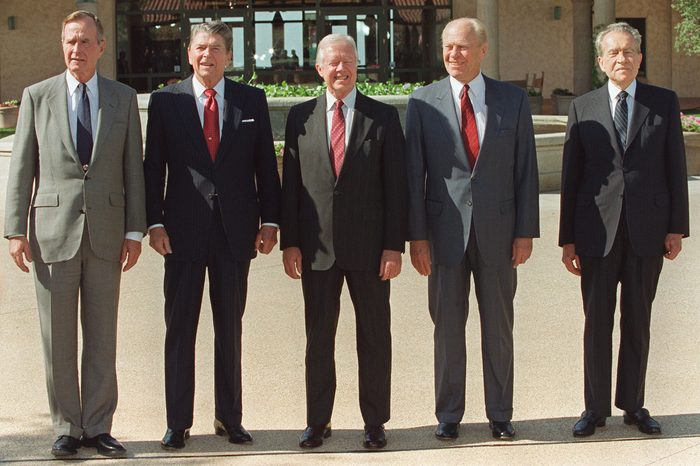
Five former presidents stand together
In 1991, in unprecedented fashion, five former U.S. presidents posed together for a photo outside the Reagan Library in Simi Valley, California. From left to right, there’s George H.W. Bush, Ronald Reagan, Jimmy Carter, Gerald Ford and Richard Nixon (which puts them in reverse chronological order of when they served).
“Anytime I’ve ever spoken to Carter about presidents, he has a great respect for them,” Cook says. “And this group of five seemed to have had a good level of respect for one another.” Indeed, two of the five, in particular, formed a lifelong bond. We’re talking about Gerald Ford and his successor, President Carter.
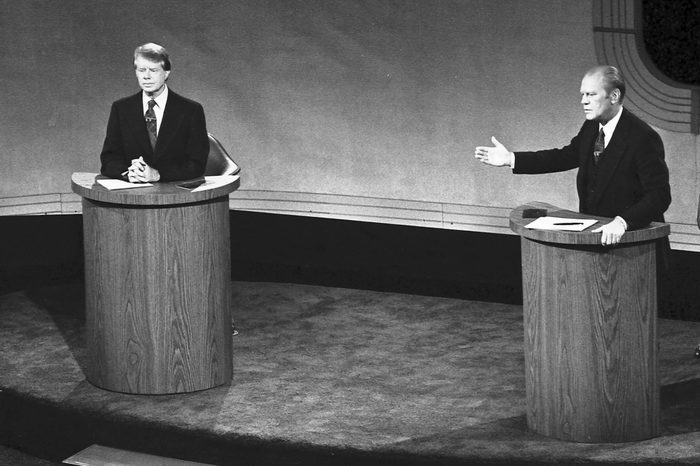
A long-standing friendship
Pictured here are Democratic Party nominee Jimmy Carter and Republican Party nominee and incumbent Gerald Ford, taking part in the first televised debate of the 1976 presidential election. When Carter defeated Ford, there was no animosity between the two, according to Cook. There was only respect, and in time, the two developed a genuine friendship that lasted for the rest of Ford’s life.
In fact, it was President Carter who gave the eulogy at Ford’s funeral. And that was at the personal request of Ford. Apparently, the men made an agreement at some point, each promising to give the eulogy at the other’s funeral. Their former first ladies were friends as well, and when Betty Ford died, it was Rosalynn who gave the eulogy.
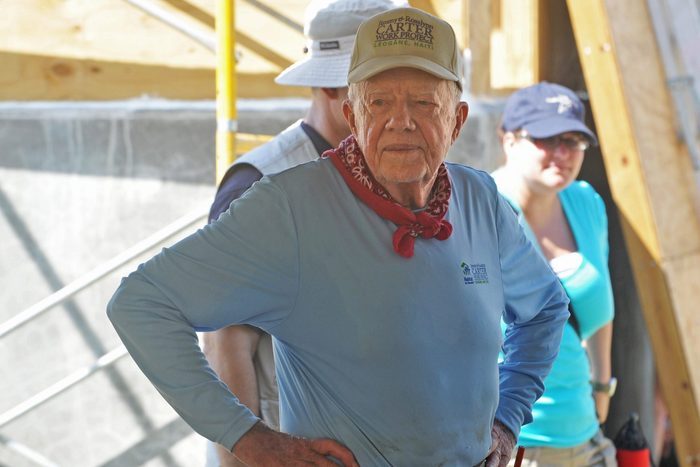
Building a better future
Of all his presidential accomplishments and post-presidency contributions, Carter may be best known for his nearly four-decade partnership with Habitat for Humanity. The organization’s mission is to bring “people together to build homes, communities and hope,” and that’s exactly what the former president has done for the past 39 years.
Together with Rosalynn, he has participated in annual weeklong Habitat for Humanity builds around the world. In this photo from 2012, an 88-year-old former President Carter is helping build a house in Port-au-Prince, Haiti. And according to Cook, the Carters really do the work. As it turns out, they’re both quite capable when it comes to woodworking.
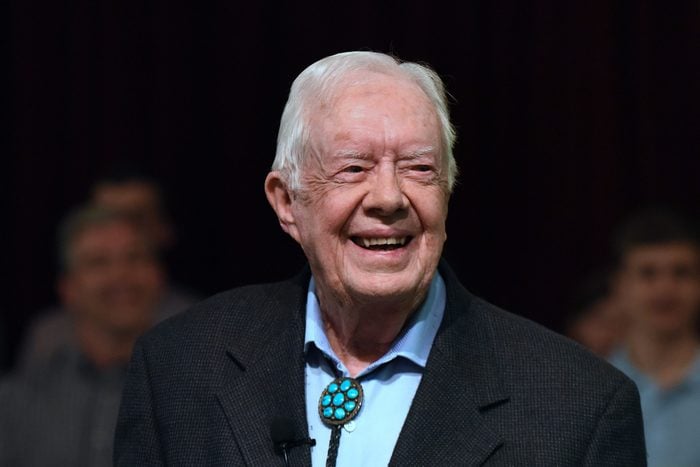
Former President Carter, the Sunday school teacher
President Carter’s 1976 presidential campaign presented him as a Christian first and foremost. He’s been a born-again Christian since age 11 and a member of his hometown’s Maranatha Baptist Church since its founding in the late 1970s.
It may seem like an unlikely job for a U.S. president to hold, but since leaving the White House in 1981, former President Carter has been teaching a weekly Sunday school class at the church. This photo, taken on April 28, 2019, shows the former president preparing to do just that.
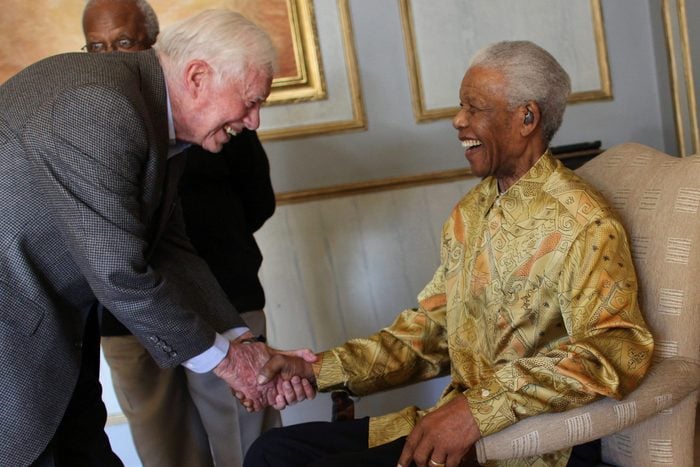
A meeting of peacemakers
In 2002, President Carter received the Nobel Peace Prize “for his decades of untiring effort to find peaceful solutions to international conflicts, to advance democracy and human rights, and to promote economic and social development,” according to the Jimmy Carter Library.
In 2007, Nelson Mandela—1993’s Nobel Peace Prize winner and, says Bird, a longtime hero of President Carter’s—founded a global organization he called The Elders for the purpose of working together for “peace, justice, human rights and a sustainable planet.” The former president was a co-founder and is a member to this day. In this photo, snapped on May 29, 2010, at a meeting of The Elders in Johannesburg, South Africa, President Carter warmly greets Mandela.
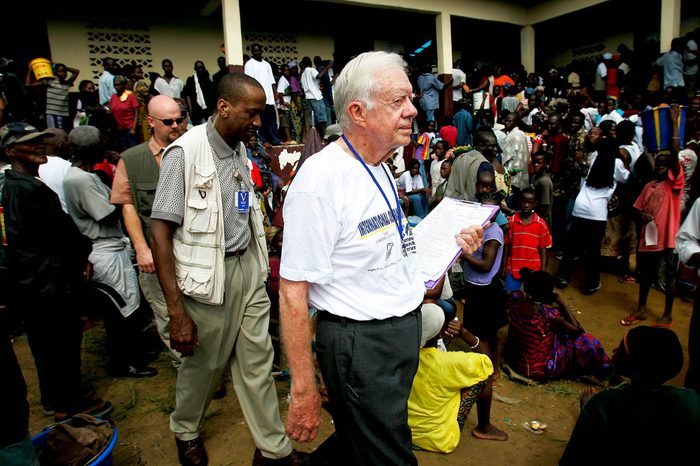
The Carter Center
When President Carter left office in January 1981, many considered his presidency a failure. But his post-presidential public service transformed the former president “from political pariah to kingmaker,” says Roessner.
Much of that service has been performed under the auspices of the Carter Center, which Jimmy and Rosalynn established in 1982 for the purpose of advancing global peace and health. Its initiatives include combating hunger, poverty, conflict, oppression and disease. Consider, for instance, his work in Liberia. In October 2005, the organization brought former President Carter to the country to help monitor elections alongside the National Democratic Institute. After 13 years of civil war and two years of tentative peace under United Nations occupation, the election was a historic achievement.
The former president has, through the Carter Center and otherwise, created an “exemplary model for future presidents to follow,” Roessner asserts. As Strong puts it, “the Jimmy Carter the American public came to admire in his years after serving in the White House … is the same Jimmy Carter who was president.” It’s just a matter of reconciling the dichotomy.
Sources:
- Laurence Cook, presidential historian and personal friend of the Carters
- Amber Roessner, professor of journalism and media history at the University of Tennessee-Knoxville and author of Jimmy Carter and the Birth of the Marathon Media Campaign
- Kai Bird, author of The Outlier: The Unfinished Presidency of Jimmy Carter
- Jonathan Alter, journalist and author of His Very Best: Jimmy Carter, a Life
- Robert Strong, author of Working in the World: Jimmy Carter and the Making of American Foreign Policy
